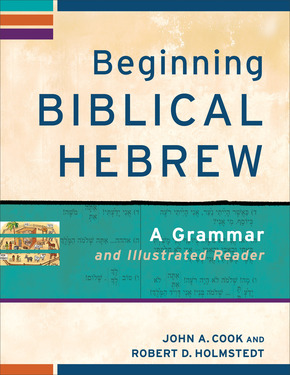This web site is for those actively or interested in teaching with our textbook, Beginning Biblical Hebrew: A Grammar and Illustrated Reader (Baker Academic 2013).
On this site we host a blog, in which we will address questions submitted by instructors or interested instructors, a forum, in which we can interact dynamically with instructors using the textbook, a resource page, where we will post “beta” (in-progress, draft) supplementary materials to use with BBH (and we welcome suggestions!), and links to the eSources that Baker has provided on their BBH textbook site.
Thank you for stopping by!
About Beginning Biblical Hebrew
This innovative textbook by two leading experts in Biblical Hebrew combines the best of traditional grammars, new insights into Hebrew linguistics, and a creative pedagogical approach. The material has been field tested and refined for more than a decade by the authors, who are actively engaged in teaching Biblical Hebrew and in scholarly discussions and research.
Beginning Biblical Hebrew includes fifty brief grammar lessons with accompanying workbook-style exercises, appendixes providing more detailed explanations, and a full-color reader–bound at the back of the book for right-to-left reading–that incorporates comics, line drawings, and numerous exercises, all in Hebrew. The work offers a realistic approach to beginning Hebrew, helping students comprehend texts without overloading them with too much information. Professors in seminary and university settings can adapt the book to either one-semester or full-year courses.
An accompanying website offers helpful resources for students and professors. Resources for students include flash cards and audio files. Resources for professors include sample quizzes, sample exams, sample lesson plans, and a full-color printed instructor’s manual.
Endorsements
“I used Beginning Biblical Hebrew in draft form with twenty undergraduates this year, and the textbook succeeded grandly. Having taught Hebrew students for the past thirty years, I can say that this present class is the most advanced I have ever had. They read extremely well, they have a good grasp of the fundamentals, and they have a developing understanding of syntax that will prepare them for subsequent study in Hebrew readings and exegesis. This grammar is characterized by current terminology, new discussions that reflect the best of what current research has to offer, and well-considered exercises and readings. I highly recommend it.”
Martin Abegg Jr., professor of religious studies and director, Dead Sea Scrolls Institute, Trinity Western University
“Each year sees the publication of several new Biblical Hebrew grammars. Invariably, their deductive approach requires a motivation-crushing amount of contextless memorization, and only a fraction of students have the heart to continue past the first semester. Cook and Holmstedt’s grammar is a breath of fresh air. It engages students at multiple levels through inductive and holistic approaches to language acquisition. If you want your students to learn Biblical Hebrew in a deep and substantial way, and help them enjoy the process as well, then this grammar is exactly what you are looking for.”
Charles Halton, Houston Baptist University
“Cook and Holmstedt have produced an innovative guide to the acquisition of Biblical Hebrew that effectively utilizes the best of contemporary linguistics and pedagogy while maintaining interest through interactive techniques and an emphasis on comprehending texts rather than grammatical principles.”
Mark A. Throntveit, Luther Seminary
“This phenomenal book accomplishes many things that I want a contemporary Biblical Hebrew textbook to do. The use of illustrations is a great step forward in vocabulary acquisition, but better still is the use of Hebrew to teach Hebrew. Even so simple a thing as writing words such as דָּגֵשׁ and בִּנְיָן in Hebrew instead of in transliteration adds significant value to this textbook, not to mention using Hebrew terms for סְמִיכוּת relationships and other grammatical concepts. Beginning Biblical Hebrew is sure to invigorate the teaching and learning of Biblical Hebrew in many classrooms.”
Chris Heard, associate professor of religion, Pepperdine University
“Because it not only embraces fresh methods but also rethinks their linguistic and pedagogical foundations, this volume will stand out in the crowded market of introductory Biblical Hebrew textbooks. This isn’t a rehash; it’s a reboot. To have these creative ideas assembled into this ambitious synthesis will allow instructors to try out new approaches with relative ease.”
Christopher B. Hays, D. Wilson Moore Associate Professor of Ancient Near Eastern Studies, Fuller Theological Seminary
“Cook and Holmstedt’s beginning Hebrew grammar and illustrated workbook stands as a welcome contribution to teachers of Biblical Hebrew. The text aims at language acquisition rather than grammar retention, and this is a point that makes the volume so useful. Current in its philosophy of language, relevant in its presentation and pedagogy, and thoroughly focused on the ancient Hebrew text, this beginning grammar will serve Biblical Hebrew language learners for years to come.”
Heath A. Thomas, director of PhD studies and associate professor of Old Testament and Hebrew, Southeastern Baptist Theological Seminary (USA); Fellow in Old Testament Studies, The Paideia Centre for Public Theology (Canada)
“For languages, childlike learning is best. As young children, people talked to us, and we quickly acquired our new language with no formal grammar. Preeminent Semitic linguists and proven teachers Cook and Holmstedt have brought us the verified successes of childlike learning and second-language acquisition strategies. The student will acquire Biblical Hebrew through sight, sound, storytelling, and playacting. Formal grammar during these early stages of learning is as it should be–minimal. Beginning Biblical Hebrew is an uncluttered, learner-friendly path to joyfully understanding Biblical Hebrew.”
Gary A. Long, professor of biblical and theological studies, Bethel University
The Authors
 John A. Cook
John A. Cook
John A. Cook (PhD, University of Wisconsin-Madison) is associate professor of Old Testament at Asbury Theological Seminary in Wilmore, Kentucky. He has taught undergraduate and graduate courses at the University of Wisconsin (Madison and Milwaukee campuses), Trinity Evangelical Divinity School, Wheaton College, and Grace College.
 Robert D. Holmstedt
Robert D. Holmstedt
Robert D. Holmstedt (PhD, University of Wisconsin-Madison) is associate professor of Near and Middle Eastern civilizations at the University of Toronto in Toronto, Ontario. His primary research interest is the linguistic study of Northwest Semitic languages.




